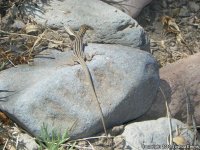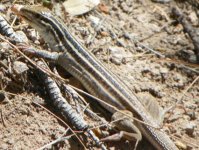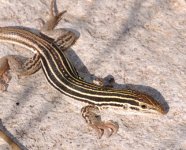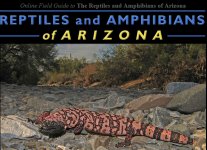| Range: |
 |
| Other Names: |
|
| Description: |
A medium-sized (up to 99 mm or 3.9" from snout to vent), slim, brown to black lizard with a long, thin tail, and a slim, pointed snout. The body is marked with six light yellow or cream stripes and relatively few light spots. The light spots are visible between and within the stripes. The tail is olive to blue-brown. The underside is plain and pale. Juveniles lack spots. The scales on the body are small and granular. The scales on the tail are large, keeled, and rectangular. The belly scales are large, smooth, and rectangular and the scales on top of the head are large, smooth, and plate-like. |
| Similar Species |
The Gila Spotted Whiptail's distinct stripes (particularly on the neck) and relatively spare spotting distinguish it from the similar looking Chihuahuan Spotted Whiptail. It differs from the Sonoran Spotted Whiptail in having the light spots in the dark dorsal fields that touch or lie within the longitudinal light stripes. The Giant Spotted Whiptail is much larger, has more than 95 granular scales around the mid-body and stripes that tend to disappear with age. |
| Venom: |
None |
| Habitat: |
Primarily an inhabitant of Great Basin Conifer Woodland, Interior Chaparral, and Madrean Evergreen Woodland communities. Its range also extends into the lower reaches of Petran Montane Conifer Forest and follows drainages and riparian corridors down into Semidesert Grassland. Usually found in relatively open and sunny areas, often along the banks of creeks and rivers. |
| Behavior: |
This is an alert, diurnal, fast-moving ground-dweller. It is often encountered foraging or basking in the mid-morning sun. |
| Hibernation: |
It hibernates during fall and winter. |
| Reproduction: |
All Gila Spotted Whiptails are female (parthenogenetic). Eggs are unfertilized and hatchlings are clones of the mother. Clutches of 2 to 6 eggs are laid in late spring or summer. |
| Diet: |
It actively forages for a variety of insects and spiders by rooting around in organic matter under bushes and digging in the soil around the bases of rocks, and other surface debris. |















